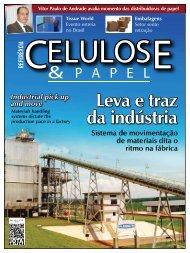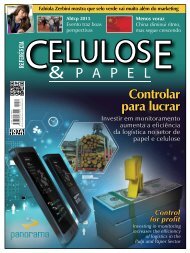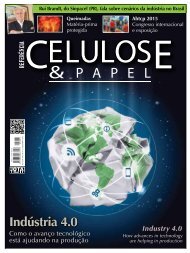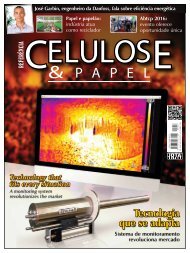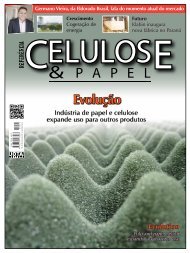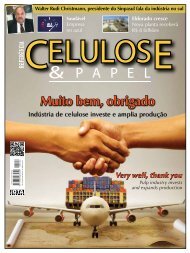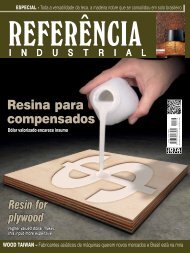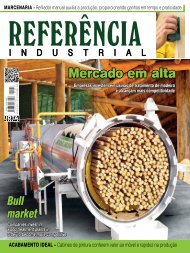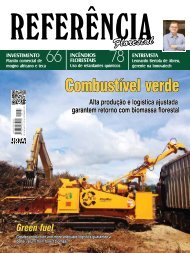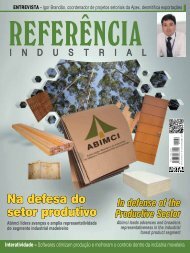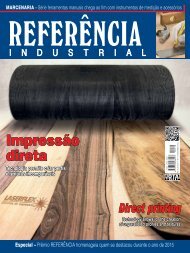Outubro/2016 - Referência Florestal 179
Visitantes - Grupo Jota Comunicação
Visitantes - Grupo Jota Comunicação
Create successful ePaper yourself
Turn your PDF publications into a flip-book with our unique Google optimized e-Paper software.
PRINCIPAL<br />
lhões de ha, que é a área plantada de eucalipto no Brasil, esse<br />
número seria muito maior”, aponta Wilcken. Foi observado que<br />
de 2010 a 2015, o percevejo-bronzeado causou R$ 1,1 bilhão<br />
em prejuízos nas empresas, considerando as perdas pela diminuição<br />
no incremento de madeira.<br />
CONHECENDO O INIMIGO<br />
Como os números mostram, entre as pragas mais importantes<br />
e com maior poder de destruição em plantios de eucalipto<br />
está o percevejo-bronzeado. Na América do Sul, ele está disperso<br />
no Brasil, Argentina, Chile e Uruguai. “É uma praga que<br />
se adapta a diversos tipos de clima e tem preferência de ataque<br />
em períodos secos”, explica Luís Renato Junqueira, coordenador<br />
executivo do Protef. Entre os sintomas está a mudança de<br />
coloração das folhas que ficam amareladas e perdem a capacidade<br />
de fotossíntese. Assim que isso acontece, o percevejo<br />
muda de área. Depois de um a três meses, as folhas secam e<br />
caem.<br />
Já a vespa-da-galha estava ligada principalmente a ataque<br />
em viveiros, era um problema para a produção de mudas. Mas<br />
a praga ampliou o leque e passou a atacar árvores adultas também.<br />
O inseto não tem restrição a temperatura e clima, apesar<br />
de sentir um pouco a umidade. “Ela está presente em países<br />
do Mediterrâneo e Oriente Médio, ou seja, ambientes bem desafiadores<br />
para insetos e ela consegue se desenvolver muito<br />
bem”, completa Luís Renato.<br />
DIAGNÓSTICO E CONTROLE<br />
A informação sobre os sintomas é o maior aliado dos produtores.<br />
“Vimos isso com o gorgulho-do-eucalipto no Estado<br />
de São Paulo. Eles viam a floresta mudando de cor, mas não associavam<br />
a mudança de cor com a presença do inseto”, afirma<br />
Luís Renato Junqueira. Um modelo bastante eficiente para saber<br />
o grau de ataque são as armadilhas amarelas e a contagem<br />
de insetos nas folhas, no caso do percevejo, por exemplo. “Verificamos<br />
que de 10 a 15 percevejos por armadilha, depois de<br />
PROFESSOR DOUTOR CARLOS FREDERICO WILCKEN ORIENTA<br />
A REALIZAÇÃO DO MANEJO INTEGRADO, COM AGENTES<br />
BIOLÓGICOS E QUÍMICOS PARA O CONTROLE DE PRAGAS<br />
Foto: REFERÊNCIA<br />
TUMORES GERADOS PELOS OVOS DA VESPA-<br />
DA-GALHA DEPOSITADOS NO PECÍOLO DAS<br />
FOLHAS DE EUCALIPTO<br />
the Cooperative Program on Forest Protection (Protef), which<br />
brings together research institutions and companies to study and<br />
combat pests. The sampled area of the 20 participating companies<br />
covers over one million hectares of planted forest. In 2012,<br />
just the bronze bug affected more than 255 thousand ha. Last<br />
year, it was closer to 80 thousand. “It is worthwhile remembering<br />
that this is just the universe of the participants, if you extrapolate<br />
this data to include 5.6 million hectares, which is the area<br />
planted with eucalyptus in Brazil, that number would be much<br />
higher,” points out Wilcken, one of the Protef Coordinators. It<br />
was observed that from 2010 to 2015, the bronze bug caused R$<br />
1.1 billion in losses for companies considering those losses due to<br />
the decrease in timber increment.<br />
KNOWING YOUR ENEMY<br />
As the numbers show, amongst the most important pests<br />
and with greatest destructive power in eucalyptus plantations<br />
is the bronze bug. In South America, it is dispersed throughout<br />
Brazil, Argentina, Chile and Uruguay. “It's a pest that adapts to<br />
different types of climate and has a preference to attack in dry<br />
spells,” explains Luís Renato Junqueira. Amongst the symptoms<br />
is the change in leaf coloring to yellowish losing its ability to<br />
photosynthesize. Once that happens, the bug moves on to a new<br />
area. After one to three months, the leaves wither and fall off.<br />
In the dry season, when the insects attack, the plant grows very<br />
little. In the rainy season, when the tree develops at full force, it<br />
spends part of its energy recuperating its leaves.<br />
When it attacks the seedling, while still in development, the<br />
mortality rate in nurseries is quite high. The blue gum chalcid<br />
causes a tumor in the plant that blocks sap movement. In the<br />
field, problems appear at branch tips, and tree development<br />
slows down. In the warmer regions, the problem is even greater<br />
Foto: divulgação<br />
36<br />
www.referenciaflorestal.com.br



